Content for TS 23.502 Word version: 18.5.0
1…
4.2.2.2.2
4.2.2.2.3…
4.2.2.3…
4.2.3…
4.2.3.3
4.2.4…
4.2.6
4.2.7…
4.2.9…
4.2.11…
4.2.11.5…
4.3…
4.3.2.2.2
4.3.2.2.3…
4.3.3…
4.3.3.3
4.3.4…
4.3.4.3
4.3.5…
4.3.5.2…
4.3.5.4…
4.3.5.6…
4.3.6…
4.4…
4.5…
4.9…
4.9.1.3…
4.9.2…
4.11…
4.11.1…
4.11.1.2.2
4.11.1.2.3
4.11.1.3…
4.11.1.3.3…
4.11.1.4…
4.11.1.5…
4.11.2…
4.11.3…
4.12…
4.12.6…
4.12a…
4.12b…
4.13…
4.13.4…
4.13.6…
4.14…
4.15…
4.15.3.2.5…
4.15.4…
4.15.6…
4.15.6.7…
4.15.6.13…
4.15.6.14…
4.15.9…
4.15.9.4…
4.15.13…
4.15.13.4…
4.16…
4.16.4…
4.16.8…
4.16.11…
4.16.14…
4.16.15…
4.17…
4.17.9…
4.18…
4.19…
4.22…
4.23…
4.23.7…
4.23.7.3.3
4.23.7.3.4…
4.23.9…
4.23.9.4…
4.23.11…
4.24…
4.25…
4.25.6…
4.26…
5…
5.2.3…
5.2.5…
5.2.6…
5.2.7…
5.2.8…
5.2.9…
5.2.12…
5.2.18…
A…
E…
F…
G
H…
4.16 Procedures and flows for Policy Framework
4.16.1 AM Policy Association Establishment
4.16.1.1 General
4.16.1.2 AM Policy Association Establishment with new Selected PCF
4.16.2 AM Policy Association Modification
4.16.2.0 General
4.16.2.1 AM Policy Association Modification initiated by the AMF
4.16.2.1.1 AM Policy Association Modification initiated by the AMF without AMF relocation
4.16.2.1.2 AM Policy Association Modification with old PCF during AMF relocation
4.16.2.2 AM Policy Association Modification initiated by the PCF
4.16.3 AM Policy Association Termination
4.16.3.1 General
4.16.3.2 AMF-initiated AM Policy Association Termination
...
...
4.16 Procedures and flows for Policy Framework p. 503
4.16.1 AM Policy Association Establishment p. 503
4.16.1.1 General p. 503
There are three cases considered for AM Policy Association Establishment:
- UE initial registration with the network.
- The AMF re-allocation with PCF change in handover procedure and registration procedure.
- EPS to 5GS mobility when there is no existing AM Policy Association between AMF and PCF for this UE.
4.16.1.2 AM Policy Association Establishment with new Selected PCF p. 504
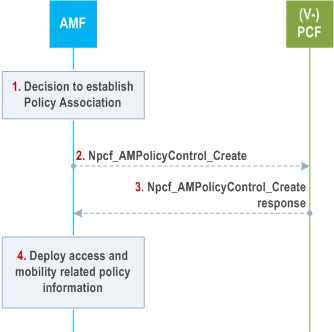
This procedure concerns both roaming and non-roaming scenarios.
In the non-roaming case the role of the V-PCF is performed by the PCF. For the roaming scenarios, the V-PCF interacts with the AMF.
Step 1.
Based on local policies, the AMF decides to establish AM Policy Association with the (V-)PCF then steps 2 to 3 are performed under the conditions described below.
Step 2.
[Conditional] If the AMF has not yet obtained access and mobility related policy information for the UE or if the access and mobility related policy information in the AMF is no longer valid, the AMF requests the PCF to apply operator policies for the UE from the PCF. The AMF sends Npcf_AMPolicyControl_Create to the (V-)PCF to establish an AM Policy Association with the (V-)PCF. The request includes the following information: SUPI, Internal Group (see clause 5.9.7 of TS 23.501), subscription notification indication and if available, Service Area Restrictions, RFSP index, Subscribed UE-AMBR, List of Subscribed UE-Slice-MBR, the Allowed NSSAI, Partially Allowed NSSAI, S-NSSAI(s) rejected partially in the RA, Rejected S-NSSAI(s) for the RA, Pending NSSAI, Target NSSAI (see clause 5.3.4.3.3 of TS 23.501), Network Slice Replacement supported for the UE (see clause 5.15.19 of TS 23.501), GPSI, which are retrieved from the UDM during the update location procedure and may include Access Type and RAT Type, PEI, ULI, UE time zone and Serving Network (PLMN ID, or PLMN ID and NID, see clause 5.34 of TS 23.501).
When AMF utilizes an NWDAF, it may add the NWDAF serving the UE identified by the NWDAF instance ID. Per NWDAF service instance the Analytics ID(s) are also included.
Step 3.
In non-roaming case, if the PCF determines that the policy decision depends on the status of the policy counters available at the CHF and such reporting is not established for the subscriber, the PCF initiates an Initial Spending Limit Report Retrieval as defined in clause 4.16.8.2. If policy counter status reporting is already established for the subscriber and the PCF determines that the status of additional policy counters is required, the PCF initiates an Intermediate Spending Limit Report Retrieval as defined in clause 4.16.8.3.
The (V)-PCF responds to the Npcf_AMPolicyControl_Create service operation. The (V)-PCF provides access and mobility related policy information (e.g. Service Area Restrictions) as defined in clause 6.5 of TS 23.503. In addition, (V)-PCF can provide Policy Control Request Trigger of AM Policy Association to AMF. In the non-roaming case, the PCF may subscribe to Analytics from NWDAF as defined in clause 6.1.1.3 of TS 23.503.
Step 4.
[Conditional] The AMF deploys the access and mobility related policy information which includes storing the Service Area Restrictions and Policy Control Request Trigger(s) of the AM Policy Association, provisioning Service Area Restrictions to the UE and provisioning the RFSP index, the UE-AMBR, List of UE-Slice-MBR, Service Area Restrictions to the NG-RAN as defined in TS 23.501 and request for notification of SM Policy association establishment and termination to a list of (DNN, S-NSSAI)(s) together with PCF for the UE binding information.
4.16.1.3 Void
4.16.2 AM Policy Association Modification p. 505
4.16.2.0 General p. 505
There are three cases considered for AM Policy Association Modification:
- Case A: A Policy Control Request Trigger condition is met: the procedure is initiated by the AMF.
- Case B: PCF policy decision per local decision or per trigger by other peers of the PCF (i.e. UDR, AF or NWDAF): the procedure is initiated by the PCF.
- Case C: AM Policy Association Modification with the old PCF during AMF relocation: the procedure is initiated by the AMF.
4.16.2.1 AM Policy Association Modification initiated by the AMF p. 505
4.16.2.1.1 AM Policy Association Modification initiated by the AMF without AMF relocation p. 505
This procedure is applicable to Case A.
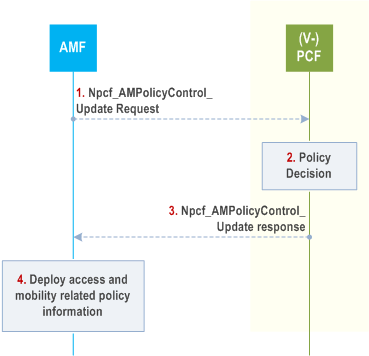
This procedure concerns both roaming and non-roaming scenarios.
In the non-roaming case the role of the V-PCF is performed by the PCF. For the roaming scenarios, the V-PCF interacts with the AMF.
Step 1.
When a Policy Control Request Trigger condition is met the AMF updates the AM Policy Association and provides information on the conditions that have changed to the PCF by invoking Npcf_AMPolicyControl_Update .
Step 2.
The (V-)PCF stores the information received in step 1 and makes the policy decision. In the non-roaming case, the PCF may subscribe to Analytics from NWDAF as defined in clause 6.1.1.3 of TS 23.503. If the PCF determines a change to policy counter status reporting is required, it may alter the subscribed list of policy counters using the Initial, Intermediate or Final Spending Limit Report Retrieval procedures as defined in clause 4.16.8.
Step 3.
The (V-)PCF responds to the AMF with the updated access and mobility related policy information as defined in clause 6.5 of TS 23.503 and the updated Policy Control Request Trigger parameters. If an AF has previously subscribed to request for allocation of service area coverage outcome event, the (V-)PCF checks if reporting is needed, using the Policy Control Request Trigger that was met (see step 1) as input, then sends a respective notification to the AF using Npcf_AMPolicyAuthorization_Notify , as defined in clause 6.1.3.18 of TS 23.503.
Step 4.
The AMF deploys the access and mobility related policy information, which includes storing the Service Area Restrictions and Policy Control Request Trigger of AM Policy Association, provisioning the Service Area Restrictions to the UE and provisioning the RFSP index, UE-AMBR, List of UE-Slice-MBR, Service Area Restrictions to the NG-RAN as defined in TS 23.501 and request for notification of SM Policy association establishment and termination to a list of (DNN, S-NSSAI)(s) together with PCF for the UE binding information.
4.16.2.1.2 AM Policy Association Modification with old PCF during AMF relocation p. 506
This procedure is applicable to Case C. In this case, AMF relocation is performed without PCF change in handover procedure and registration procedure.
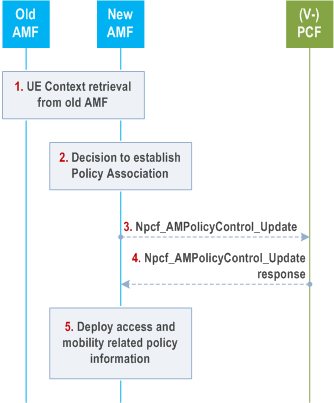
This procedure concerns both roaming and non-roaming scenarios.
In the non-roaming case the role of the V-PCF is performed by the PCF. For the roaming scenarios, the V-PCF interacts with the AMF:
Step 1.
[Conditional] When the old AMF and the new AMF belong to the same PLMN, the old AMF transfers to the new AMF the AM Policy Association information including Policy Control Request Trigger(s) and the PCF ID. For the roaming case, the new AMF receives V-PCF ID.
Step 2.
Based on local policies, the new AMF decides to establish an AM Policy Association with the (V-)PCF and contacts the (V-)PCF identified by the PCF ID received in step 1.
Step 3.
The new AMF sends Npcf_AMPolicyControl_Update to the (V-)PCF to update the AM Policy Association with the (V-)PCF. The request may include the following information: Policy Control Request Trigger which has been met, Subscribed Service Area Restrictions (if updated), subscribed RFSP index (if updated) which are retrieved from the UDM during the update location procedure and may include access type and RAT, PEI, ULI, UE time zone, service network. The (V-)PCF updates the stored information provided by the old AMF with the information provided by the new AMF. In the non-roaming case, the PCF may subscribe to Analytics from NWDAF as defined in clause 6.1.1.3 of TS 23.503. If the PCF determines a change to policy counter status reporting is required, it may alter the subscribed list of policy counters using the Initial, Intermediate or Final Spending Limit Report Retrieval procedures as defined in clause 4.16.8.
When AMF utilizes an NWDAF, it may add the NWDAF serving the UE identified by the NWDAF instance ID. Per NWDAF service instance the Analytics ID(s) are also included.
Step 4.
The (V-)PCF may update the policy decision based on the information provided by the new AMF and responds to the Npcf_AMPolicyControl_Update service operation providing access and mobility related policy information as defined in clause 6.5 of TS 23.503. If an AF has previously subscribed to request for allocation of service area coverage outcome event the (V-)PCF checks if reporting is needed, using the Policy Control Request Trigger that was met (see step 1) as input, then sends a respective notification to the AF using Npcf_AMPolicyAuthorization_Notify , as defined in clause 6.1.3.18 of TS 23.503.
Step 5.
The AMF deploys the access and mobility related policy information, which includes storing the Service Area Restrictions, provisioning Service Area Restrictions to the UE and provisioning the RFSP index, UE-AMBR, Service Area Restrictions to the NG-RAN and request for notification of SM Policy association establishment and termination to a list of (DNN, S-NSSAI)(s) together with PCF for the UE binding information.
4.16.2.2 AM Policy Association Modification initiated by the PCF p. 507
The AM Policy Association modification procedure may be initiated by an internal PCF event or by PCF obtaining pertinent analytics information from an NWDAF.
The following procedure is applicable to AM Policy Association modification due to Case B.
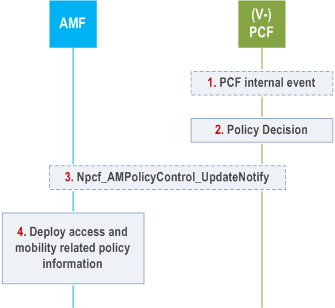
The procedure driven by a PCF internal event applies to both roaming and non-roaming scenarios and when driven by NWDAF or CHF, applies only to non-roaming scenarios.
An AM Policy Association is established, with the V-PCF in case of roaming or with the PCF in a non-roaming case as described in clause 4.16.1.2 before this procedure is triggered.
In the non-roaming case the role of the V-PCF is performed by the PCF. For the roaming scenarios, the V-PCF interacts with the AMF.
Step 1.
[Conditional] The PCF determines internally that the new status of the UE context requires new policies, potentially triggered by an AF as described in clause 4.15.6.9 or by a notification from the UDR or optionally, the CHF provides a Spending Limit Report to the PCF as described in clause 4.16.8. This may be triggered by obtaining pertinent analytics information from an NWDAF as described in clause 6.1.1.3 of TS 23.503.
Step 2.
The (V-)PCF in case of roaming and PCF in a non-roaming case makes a policy decision. The PCF may also decide to subscribe to a new Analytics ID from NWDAF as described in clause 6.1.1.3 of TS 23.503.
Step 3.
The (V-)PCF in the roaming case and the PCF in a non-roaming case sends Npcf_AMPolicyControl_UpdateNotify including AM Policy Association ID associated with the SUPI defined in TS 29.507. The policy update may include Service Area Restrictions, UE-AMBR, RFSP index value and RFSP Index in Use Validity Time, access stratum time distribution indication, Uu time synchronization error budget, clock quality detail level and optionally clock quality acceptance criteria. If an AF has previously subscribed to event request for allocation of service area coverage outcome in step 1, the (V-)PCF checks if the allocated service area coverage was changed and sends a respective notification to the AF using Npcf_AMPolicyAuthorization_Notify as defined in clause 6.1.3.18 of TS 23.503.
Step 4.
The AMF deploys and stores the updated access and mobility related policy information, which includes storing the Service Area Restrictions and Policy Control Request Trigger of AM Policy Association, provisioning of the Service Area Restrictions to the UE, provisioning the RFSP index, UE-AMBR, Service Area Restrictions to the NG-RAN, optionally the access stratum time distribution indication, Uu time synchronization error budget, clock quality detail level and optionally clock quality acceptance criteria to the NG-RAN and request for notification of SM Policy association establishment and termination to a list of (DNN, S-NSSAI)(s) together with PCF for the UE binding information.
4.16.3 AM Policy Association Termination p. 508
4.16.3.1 General p. 508
The following case is considered for AM Policy Association Termination:
- UE Deregistration from the network.
- The mobility with change of AMF (e.g. new AMF is in different PLMN or new AMF in the same PLMN).
- [Optional] 5GS to EPS mobility with N26 if the UE is not connected to the 5GC over a non-3GPP access in the same PLMN.
4.16.3.2 AMF-initiated AM Policy Association Termination p. 509
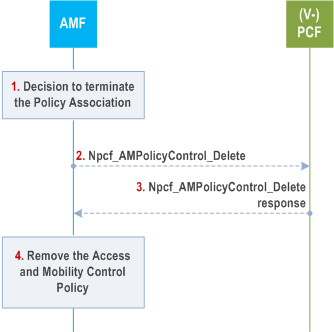
This procedure concerns both roaming and non-roaming scenarios.
In the non-roaming case the role of the V-PCF is performed by the PCF. For the roaming scenarios, the V-PCF interacts with the AMF.
Step 1.
The AMF decides to terminate the AM Policy Association during Deregistration procedure or due to mobility with change of AMF and (V-)PCF in the registration procedure or handover procedure, then if a AM Policy Association was established with the (V-)PCF steps 2 to 3 are performed.
Step 2.
The AMF sends the Npcf_AMPolicyControl_Delete service operation including AM Policy Association ID to the (V-)PCF.
Step 3.
The (V-)PCF removes the policy context for the UE and replies to the AMF with an Acknowledgement including success or failure. In the non-roaming case, the PCF may unsubscribes to analytics from NWDAF. The (V-)PCF may deregister from the BSF as the PCF that handles the AM Policy Association for this UE. This is performed by using the Nbsf_Management_Deregister service operation, providing the Binding Identifier that was obtained earlier from the BSF when performing the Nbsf_Management_Register service operation.
If the PCF has subscribed to the policy counter status to the CHF, it invokes the procedure defined in clause 4.16.8 to unsubscribe to policy counter status reporting.
Step 4.
The AMF removes the AM Policy Association for this UE, including the Access and Mobility Control Policy related to the UE. The AMF deletes the subscription to AMF detected events requested for that Policy Association.